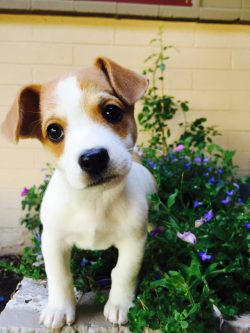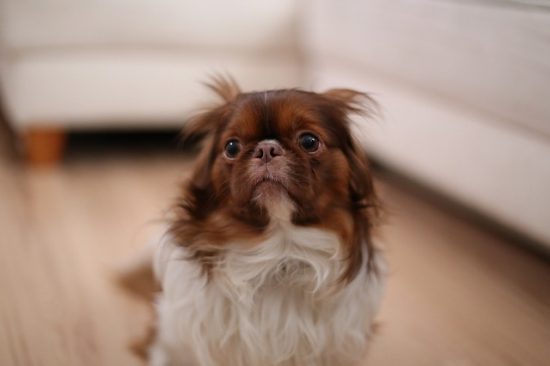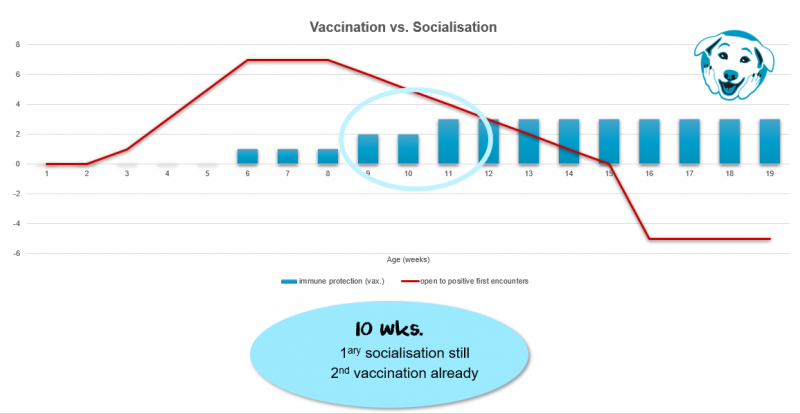Written by Laure-Anne Viselé-Jonkman
On 16 February 2021
Photo credits at the end of this post
At what age should my pup start with puppy classes?
Puppy owners often struggle with this question:
- On the one hand, you read everywhere that you should start as soon as possible with socialisation
- On the other hand, young pups are not fully vaccinated.
The answer is a compromise: start just after the peak of the first socialisation age and just before the puppy is fully vaccinated.
Puppies not fully vaccinated: the risks
For you to even consider puppy class, your pup should at least have his second vaccination. Pups usually get this jab at the age of 9 weeks. When your pup has just had a jab, it is wise to give it a couple of days and not go immediately to the puppy school (partly because, emotionally, that probably made a bit of an impression and we want the pup to recover before he has another ‘first time’).
Responsible dog training schools further minimise the risks by restricting access to their training location to only the dogs of their clients’ dogs, and by thoroughly checking these guys’ vaccination status. This means that you effectively run less danger at the dog training school than on the street.

Responsible dog training schools all keep contacts between the pups to a minimum (Read here for the other reasons why you don’t socialize your puppy during puppy class, but between lessons).
But there is still a risk, right? That’s right, every time you go out with your puppy, especially in places where other dogs also go, he could become infected with a communicable disease. These risks have already been closely examined by a many wide-ranging studies and the conclusion is that, after the 2nd vaccination, the risk of developing severe behavioural problems trumps that of catching a vaccine-preventable diseases (see Position Statement of the American Veterinary Medical Association on this).
Why can’t the puppies be socialized later?
Because of fear, and the typical way in which it develops in dogs.
Just like human babies, young puppies hardly know danger. Fortunately, they can’t themselves in too much trouble as they can barely move at the beginning, so they are pretty much stuck to their mother and the safety of the litter.
The more they move about, the more they can experience the world. From the moment their eyes open (and their motor skills allow it) – that is approx. 2-3 weeks – they get to start exploring the world. This is motivated by a peak in curiosity (aka ‘novelty bias’ if you want to be fancy about it) and ‘glass-half-full’ism’ (aka ‘optimistic bias’). Nature is clever like that. So there we are: our pup can move and see/hear/smell AND they love anything that is new plus they don’t scare easily. ‘Hello, lion! Nice to meet you.’ Just like human toddlers.

Around the age of 6 weeks, they reach a peak in optimism and curiosity. So now the pups not only can move about more, but they like everything and everyone. This, in combination with a third factor, is what makes this period so important.
What is the third factor? Their brains make new pathways that will form the basis of life-long associations: these pathways are then used as a model for all future encounters of the same kind. In other words, the first impression counts enormously in a young puppy.
So there you have your answer to the question: why socialise so young? Because your puppy:
- Can move independently and see/hear/smell
- Is enormously driven to meet new things and people and does not scare easily
- Will use these first-times as a model for how these future encounters will go.
At that age, your pup is a sort of “experience classification” machine:
- Cat 1 = good
- Cat 2 = ouch!
- Child 1 = good
- Big man 1 = good
- Big man 2 = good
- Child 2 = good
- Cat 3 = good
- Big man 3 = good
- Child 2 = good
- Other dog 1 = ouch
- Other dog 2 = good
- Other dog 3 = ouch
Because a dog who likes cats, dogs and people makes a much nice companion than a dog who finds them scary or irritating, we make sure that very young pup get to know as many people, cats, children, and dogs in this period as possible.

As they get older, dogs become more cautious. This is because the fear emotion is developing. Your hitherto happy-go-lucky pup start to be less open to new encounters and experiences. His social curiosity then plummets to what we call ‘the fear phase:’ when your puppy suddenly acts scared of your neighbour’s wheelie bin when he’d never been bothered with it.
When does the fear stage start? Around 4 months. From 4 months of age – and throughout your dog’s adolescent period – your agenda is firmly on protection mode: During this period you build up on the positive experiences of his puppyhood instead of looking for new sensations. Human children also experience this period: they are, up to a certain age, completely uninhibited and then suddenly become shy and insecure with strangers.
So what is the ideal age to join puppy classes?
Our rule of thumb is 10 weeks.
It does remain a compromise, and every dog and circumstances are different, but you can use 10 weeks as a rough guideline.
(also open in times of Corona)
Read more about our puppy classes
Photo credits
- Jack Russell puppy with plant: Courtesy of David Clarke from Unsplash. License: Unsplash license. No modifications made.
- Scared Pekingese: Courtesy of Laura Tara from Pixabay. License: Pixabay license. No modifications made.
- Vaccination vs. socialisation graph: By Laure-Anne Viselé-Jonkman, OhMyDog, all rights reserved.
